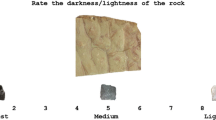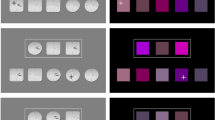Abstract
Many of our categorization experiences are non-transitive. For some objects a, b and c, a and b can appear indistinguishable, and likewise b and c, but a and c can appear distinguishable. Many categories also appear to be smooth; transitions between cases are not experienced as sharp, but rather as continuous. These two features of our categorization experiences tend to be addressed separately. Moreover, many views model smoothness by making use of infinite degrees. This paper presents a methodological strategy that shows how solving the transitivity problem first can thereby introduce explanatory resources that feed into an account of smoothness without having to make use of infinite degrees.


Similar content being viewed by others
Notes
Consider the acoustic continuum called the second-formant transition, which subdivides the stop-consonant categories /ba/, /da/ and /ga/. Although these stop-consonants are equally distance from each other on the continuum, /ba/ and /da/ are experienced as being less different than when either is paired with /ga/.
As opposed to, for example, the observational predicates thought to correspond to our experiences. This distinction is difficult to nail down, but some examples of how we talk differently about them should suffice for now. Predicates are often said to be linguistic entities, the sorts of things that can be instantiated by objects. Our experiences, on the other hand, are the sorts of things that have a duration, they happen to us. The two are of course related. For example, we use our experiences of categorizing red things to inform our thinking about the predicate is red, and there may be ways by which learning a predicate like is crimson influences our experience of categorizing red things. Most of the time it is unnecessary to make this distinction, but it will be useful to have in some places.
Fuzzy logics are a paradigm example. See Bergmann (2008).
The argument made below will apply to even weaker strategies, in that it relies only on density: between any two points x and y, there is another point z whose distances to x and y are smaller than the distance between x and y.
This is not to suggest that I am the first to take up this kind of interest. For example, Dummett’s work is relatedly concerned with observational predicates, particularly with regard to whether a relevant criterion of identity can be formulated for phenomenal qualities (see Dummett 1975). His ultimate concern, however, is focused on the coherence of observational predicates in the context of natural language semantics, a concern that I am explicitly hedging against.
This may itself be problematic unless one thinks that appearances can be infinitely rich (which is not likely to be true of our perceptual faculties).
To see this style of argument in action, see Bergmann 2008, Chpt. 1.
This strategy is akin to modeling curvatures, like that of a circle, by introducing polygons with more and more sides of equal length.
For a more indepth consideration of this sort of argument, see Williamson 1996, §4.7.
This also assumes that the number base is finite as well.
A similar point has been made in Halpern (2004). He suggests that in order to account for intransitivities in indistinguishability, we must drop the assumption that, e.g., the number of grains of sugar uniquely determines the reading of a sweetness sensor.
Similar strategies are used in Bayesian epistemology to model indeterministic probabilities: either functions that can take on sets of values instead of single values, or with sets of functions rather than single functions. See Weisberg (2007) for a brief discussion.
What it means for a classification rule to be “selected” is discussed more concretely in “Implementation”–an abstract understanding will do for now.
In addition to the empirical study cited above, this possibility is also discussed in Graff (2002).
In fact, as we increase the size of the set of cases, we increase the number of cases that will appear the same under a given classification rule. (Of course, we also thereby increase the number of possible classification rules, constrained by a function of the size of A).
The point is not the same as saying that one’s eyes cannot look beyond one’s facial structure (all other things being fixed). The claim is that one’s visual field fades away at the edges.
And as we already suggested, there may be technical reasons for doing so in the case of theorizing.
How exactly the connection weights are updated depends on the learning algorithm that is being used. Back Propogation is a relatively popular way to update a network.
References
Bergmann, M. (2008). An introduction to many-valued and fuzzy logic: Semantics, algebras, and derivation systems. Cambridge: Cambridge University Press.
Dale, R., Hindy, N., Spivey, M. (2006). Feature-semantic gradients in lexical categorization revealed by graded manual responses. In: Proceedings of the 28th Annual Meeting of the Cognitive Science Society. : Lawrence Erlbaum.
Douven, I., Decock, L., Dietz, R., Égré, P. (2010). Vagueness: A conceptual spaces approach. Journal of Philosophical Logic, pp. 1–24.
Dummett, M. (1975). Wang’s paradox. Synthese, 30, 301–324.
Fine, K. (1975). Vagueness, truth and logic. Synthese, 30(3), 265–300.
Gärdenfors, P. (2000). Conceptual spaces. Cambridge: MIT Press.
Graff, D. (2002). Shifting sands: An interest-relative theory of vagueness. Philosophical Topics, 28(1), 45–82.
Halpern, J. (2004). Intransitivity and vagueness. In: Proceedings of the ninth international conference on principles of knowledge representation and reasoning (KR 2004), pp. 121–129.
Hampton, J. (2007). Typicality, graded membership, and vagueness. Cognitive Science: A Multidisciplinary Journal, 31(3), 355–384.
Harnad, S. (1987). Psychophysical and cognitive aspects of categorical perception: A critical overview. In: Categorical perception: The groundwork of cognition (pp. 1–52). : Cambridge University Press.
Keefe, R., & Smith, P. (1996). Vagueness: A reader. Cambridge: MIT press.
Raffman, D. (1996). Vagueness and context-relativity. Philosophical Studies, 81, 175–192.
Rosch, E. (1975). Cognitive representations of semantic categories. Journal of Experimental Psychology: General, 104(3), 192–233.
van Deemter, K. (2010). Not exactly: In praise of vagueness. Oxford: Oxford University Press.
Weisberg, J. (2007). Varieties of bayesianism. In E. Gabbay,. Hartmann & J. Woods & (Eds.), Handbook of the History of Logic, vol. 10. Amsterdam: North-Holland Publishing Company.
Williamson, T. (1996). Vagueness. London: Routledge.
Wright, C. (1976). Language mastery and the sorites paradox. In E. McDowell (Eds.), Truth and meaning: Essays in semantics (pp. 223–47). Oxford: Clarendon Press.
Wright, C. (1987). Further reflections on the sorites paradox. Philosophical Topics, 15, 227–90.
Acknowledgments
I would like to thank Bernard Molyneux for his help in the initial formulation of these ideas, and Robbie Hirsch for his suggestions on how to structure the dialectic. I would also like to thank the anonymous reviewers, whose constructive feedback helped significantly improve the paper. I am grateful to Michael Trestman, Adam Sennet, and Ted Shear for the discussions we had at various points in the development of this paper. Finally, I would like to thank the participants of the Fourth Workshop on the Philosophy of Information.
Author information
Authors and Affiliations
Corresponding author
Rights and permissions
About this article
Cite this article
Baumgaertner, B. Smooth Yet Discrete: Modeling Both Non-transitivity and the Smoothness of Graded Categories With Discrete Classification Rules. Minds & Machines 24, 353–370 (2014). https://doi.org/10.1007/s11023-013-9328-0
Received:
Accepted:
Published:
Issue Date:
DOI: https://doi.org/10.1007/s11023-013-9328-0




